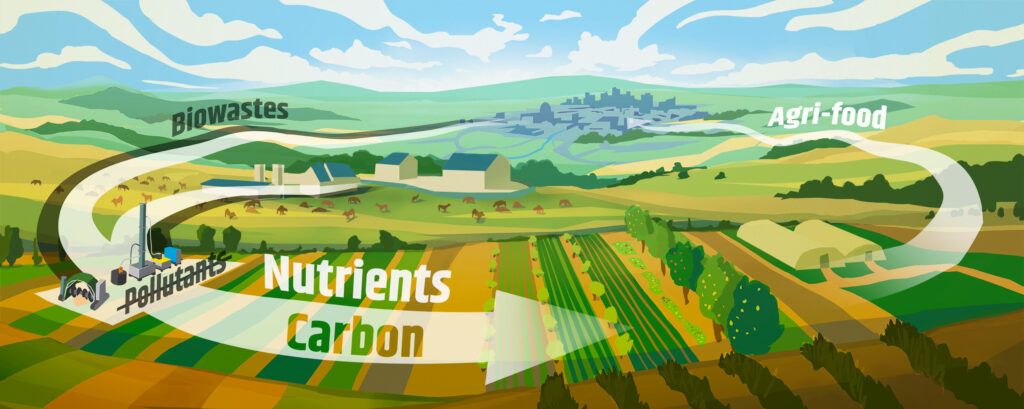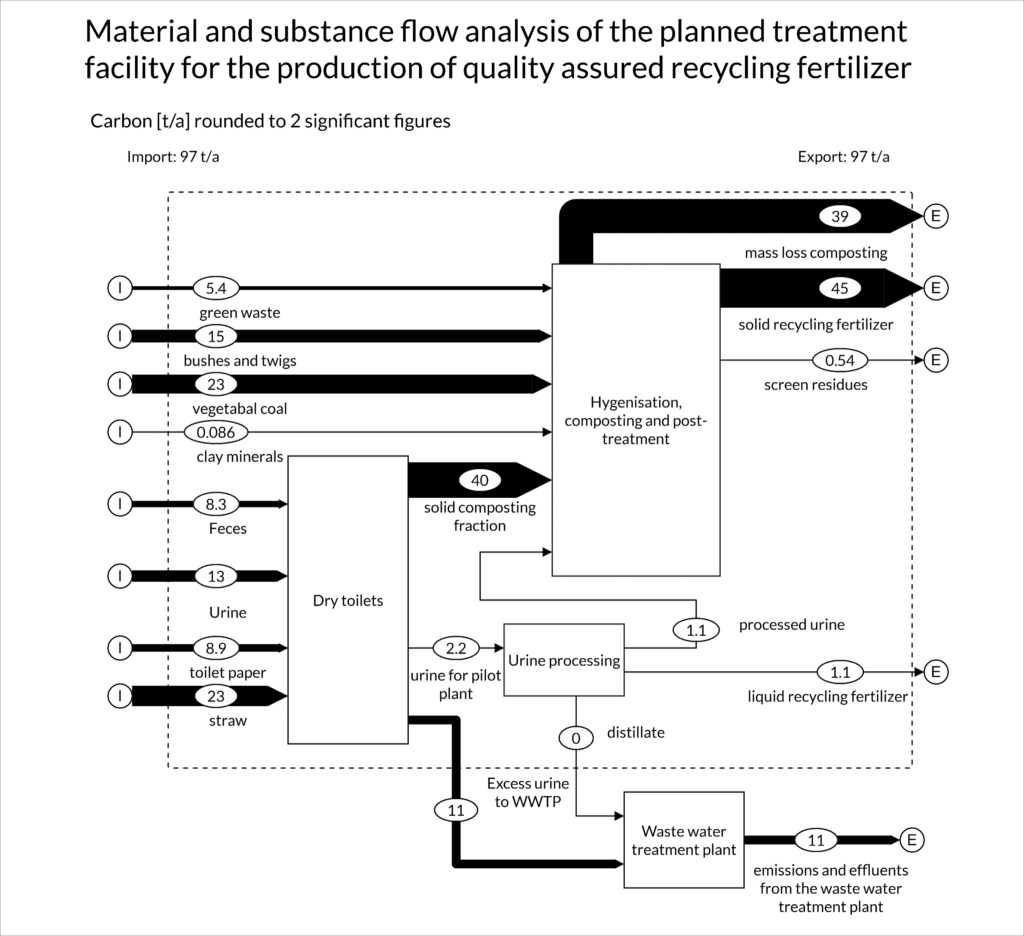ESPC4 20-22 June 2022 Poster Session
zirkulierBAR
Nutrient recycling with dry toilets as sustainable solution for communal waste management and regional economies
About the project
zirkulierBAR is an interdisciplinary and transdisciplinary research project which is funded for three years by the German Federal Ministry of Education end Research (BMBF) within the funding measure REGION.innovativ. Under zirkulierBAR, municipalities and forward-thinking companies, together with universities and research institutes, are creating a “living lab” for a sustainable regional circular economy.
In the city of Eberswalde, located in the region of Barnim, zirkulierBAR builds an innovative and scalable research plant for recycling-oriented treatments of contents from dry toilets. The final products are nutrient-rich and low-pollutant recycling fertilizers for horticulture and agriculture. Municipalities can thereby plan and implement water and resource efficient alternatives to linear water-based sewer systems.
Towards a sustainable regional circular economy

Linear anthropogenic nutrient flows [Hader et al, 2021] perturbate the natural geochemical Phosphorus and Nitrogen cycles, one of nine planetary boundaries, which together outline a a safe conditions for the human population on earth [Steffen et al, 2015]. The transgression of the planetary boundary for geochemical cycles predominantly arises from fertilizer application from agriculture [Steffen et al, 2015], which is also strongly impacting at least four other planetary boundaries [Campbell et al, 2017]. The effects of Nitrogen and Phosphorus pollution, even though defined as a planetary boundary are primarily on regional and local level [de Vries et al, 2013, Steffen et al. 2015]. This does not neglect the concept of an planetary boundary for geochemical cycles, but calls for aggregated regional boundaries as inorganic or chemical fertilizer application differs widely across world regions [de Vries et al, 2013] and thus action on the nutrient recycling and management need to be though regionally [van der Weil, 2019] and inter-regionally [Harder et al 2021]. The reduction of the regional nutrient throughput through the local recycling fertilizers will foster the transition to a sustainable regional circular economy [Harder et al, 2021].
Even though the human Nitrogen metabolism is about 5 % of the total productive reactive nitrogen, there is an resource perspective an energy and economical incentive to recover these nutrients [Larsen 2007]. The long-term sustainability of the conventional water based sanitation system has been increasingly been called into question, for both high and low-income countries. High costs for infrastructure and treatment, high water and energy demand, as well as the a more resource focused view from municipal solid and liquid waste – demand change of the conventional sanitary system. The source separation and separate treatment of human excrements reduced dilution and contamination of nutrient while providing better options for recourse recovery. [Harder, 2019]
There reasons for a sanitary- and nutrient-revolution have been brought forward by the a group of researcher and practitioners (nährstoffwende.de) [Krause et al, 2021].
- Resource recovery – Instead of disposing of our feces, we must the recyclable materials it contains must be recyclable materials in the sense of the should be the focus.
- Water scarcity – Against the backdrop of climate change and water scarcity, the demand for water for for the transport of feces must be reduced and the water pollution with nutrients and pollutants. pollutants must be prevented.
- Technical feasible – Nutrient recycling from human feces from human feces with simultaneous removal of pollutants is possible, and thus in harmony with human and environmental health.
The technical feasibility, along with the resource circularity and socio-economy perspective are two very important aspects of the project zirkulierBAR and crucial for the evaluation and success of the project.
Method and materials
The Method
Explorative material flow analysis is a well-established research method to investigate and explore flow regimes of system i.e. a first approximation of the flows, stocks and processes governing the throughput of the system [Brunner & Rechberger 2016, MinFuture 2018]. The methodology of material flow analysis is profoundly described in Brunner & Rechberger (2016) handbook of material flow analysis.
A material flow analysis follows the consequential steps of goal or problem definition, system description, data acquisition, material balancing, and scenario building followed by the subsequent interpretation. All the steps are iterative, thus in case of inconsistencies or deviation of the defined goal, the modelling process may revisit and redefine or refine to any previous step [Rechberger & Brunner, 2016]. Material flow can give insights in the total material throughput and pathways of goods. Linking these material flows with substance mass fraction will reveal the substance specific sources and sinks and allow the specific recommendations to improve substance flows.
The System
The system model living-laboratory comprises the dry toilets with serial or parallel urine separation, an aggregated process of hygienisation, composting and post-treatment comprising an thermophilic hygienisation, passive aerated windrows and sieving, an aggregated process of urine processing containing stabilization & purification and distillation as well as a external WWTP.
Additional input to dry toilets are toilet paper and straw powder. For the composting process bio char, shredded branches and twigs, green waste, and clay minerals as well as a part of mature compost are added to the fresh windrow. The windrow is turned and waters regularly, also stabilized and purified urine is added to increase the nitrogen content and reduce fresh water consumption. After 6-8 weeks the mature compost is sieved, oversize material and mature compost are returned in a fresh compost windrow, impurities are disposed.
The separated urine, disregarding the collection system (in parallel or serial urine separation) shall be stabilized and purified in the VUNA-process (https://vuna.ch/en/urin-recycling-technologie/). Half of the treated urine is used to further processed in distillation process to concentrated liquid fertilizer and distillate which is discharged to the waste water treatment plant. The other half of the treated urine is used for watering of the compost to increase nitrogen (nitrate) content in the compost product. Excess urine can not be treated as the living-laboratory at the current stage. In the future, additional treatment capacity shall prevent the discharge of valuable and nutrient to the waste water treatment plant.
Data collection
Data on mass flows the composting an urine processing was provided by Finizio – future sanitation. Material composition for urine, feces, green waste, toilet paper were obtained from literature [Boldrin 2008, Bauhaus-Universität Weimar 2009, Krogmann et al 2010]. Data from straw, clay minerals and biochar were taken from pre-test laboratory analysis. All values were considered to have an 10 % standard uncertainty.
System modeling
The material flow analysis is compiled with STAN 2.6. Mass flows were based on the information by the compost producers. No data reconciliation was performed. Result are rounded to two significant figures.
The mass flow are normalized to 1000 population equivalents („Einwohnergleichwerte“) used for the design of waste water treatment plants in the German-speaking area [Gujer 2007]
Results & Discusion
Once the living-laboratory is completely set up, it shall treat about 860 tons of dry toilet matter (urine and feces). About 3.8 ton of recycling fertilizer are produced from each ton of feces input. Mass loss during composting, by oxidation and evaporation is assumed to be 40 %, screening residues are expected to account for 1 to 2 % of the compost windrow before sieving. Most material is lost by the limited urine treatment capacities, as more than 80 % of the input urine is discharged to the waste water treatment plant.
Carbon flows are ruled by straw, added to the toilets, as well as by bio char, constituting almost half of the input carbon. Stabilized carbon in solid recycling fertilizer is the major carbon flow, in similar quantities as the total input by straw and bio char.
Urine provides the largest N input to the system. While 70 % of the total input is consequently lost, through the discharge of excess urine to the WWTP. However, the solid recycling fertilizer still comprises an considerable amount of Nitrogen (20 %) of the inputs from dry toilets.
Also Phosphorus flows are dominated by urine input. However, considerable amounts are also provided by feces and eventually in recycling fertilizers (about 40 %).
The overall treatment capacity of the zirkulierBAR living-laboratory equals a waste water treatment plant (WWTP) with a capacity of about 910 EWG („Einwohnergleichwerte“ – population equivalent values, design parameters for waste water treatment in the German-speaking area), normalized to chemical oxygen demand COD [Gujer, 2007]. In this regard the living-laboratory would be one of the 4150 WWTPs with less than 1000 EWG (> 43 % of all WWTPs in Germany). These small scale WWTP treat however, only about 1.1 % of the waste water treated.
All figures of the MFA and SFA systems can be found below.
Material mass flows

Carbon flows are ruled by straw, added to the toilets, as well as by bio char, constituting almost half of the input carbon. Stabilized carbon in solid recycling fertilizer is the major carbon flow, in similar quantities as the total input by straw and bio char.
Nitrogen flows

Urine provides the largest N input to the system. While 70 % of the total input is consequently lost, through the discharge of excess urine to the WWTP. However, the solid recycling fertilizer still comprises an considerable amount of Nitrogen (20 %) of the inputs from dry toilets.
Carbon flows

Carbon flows are ruled by straw, added to the toilets, as well as by bio char, constituting almost half of the input carbon. Stabilized carbon in solid recycling fertilizer is the major carbon flow, in similar quantities as the total input by straw and bio char.
Phosphourus flows

Also Phosphorus flows are dominated by urine input. However, considerable amounts are also provided by feces and eventually in recycling fertilizers (about 40 %).
Reference
https://doi.org/10.1016/j.cosust.2013.07.004


